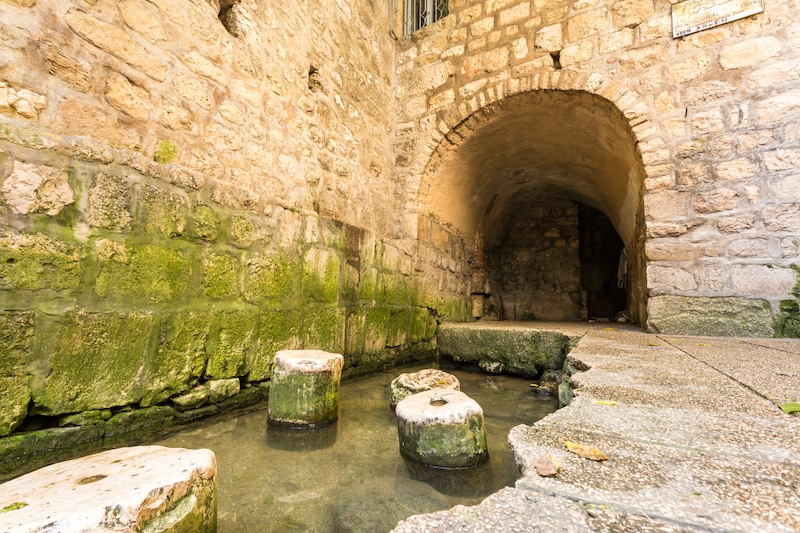Growing up, one thing that made me interested in history and archeology was Indiana Jones. After several decades in multiple history departments, I have yet to meet an archeology professor who reminds me of Indiana Jones. But if I was pressed to choose someone, it would be Professor Gershon Galil from Israel’s University of Haifa.
Over the years, I have enjoyed many of Galil’s books and articles. Galil is a historian who has challenged accepted ideas in his field throughout his entire professional life. This month, Galil and his colleague Professor Eli Shukrun, a noted archeologist of the biblical period, made some interesting interpretations of archeological finds that if correct, could change the field of biblical studies.
Interpreting Ancient Inscriptions
On December 14, Galil published a general description of his recent findings on his personal Facebook page. According to his Facebook page and JewishPress.com, Galil and Shukrun interpreted six inscriptions in “a Canaanite pool” near the Gihon Spring, which is connected to the Siloam Tunnel in eastern Jerusalem. The inscriptions, connected to King Hezekiah, contain hundreds of words and extensive information referencing events mentioned in the Hebrew Bible.

As Professor Galil stated to JewishPress.com, “I managed to decipher five new monumental royal inscriptions of King Hezekiah of Judah, which together include dozens of lines and hundreds of letters. The inscriptions mention the name of Hezekiah, king of Judah, and summarize his main actions in the first seventeen years of his reign, among them, the quarrying of Nikbat Ha’Shiloah and its pool; the ritual reform; the conquest of Philistia; and his accumulation of great wealth.”
He added, “We now have seven inscriptions of King Hezekiah, found in the City of David: two at the end of the Shiloah channel, four near the spring, of which two are at the beginning of the Shiloah channel, and two at the Canaanite pool or near it. Another inscription was found halfway between the spring and the pool. These inscriptions probably included more than 1,600 letters.”
The Siloam Tunnel is a popular tourist destination. According to the Hebrew Bible (2 Kings 20:20 and 2 Chronicles 32:3-4), King Hezekiah of Judah had this water tunnel created to bring water from the Gihon Spring to the Pool of Siloam. The tunnel was intended to provide fresh water to Jerusalem, since the city was under siege by the forces of Assyrian king Sennacherib.
According to Arkeonews, archeologists also discovered a stone tablet during a 2007 excavation at the City of David National Park in Jerusalem. After a decade of research, Galil and Shukrun have provided an interpretation of the inscriptions on this tablet.
According to CBN News, Galil and Shukrun believe the inscriptions include:
- King Hezekiah’s name
- The date that the Siloam Tunnel and Pool of Siloam were completed
- A reference to King Hezekiah’s war against the Philistines
- Reforms of Jewish rituals
Over time, pictures of the inscriptions have been published, and interested scholars in the field of biblical studies will be able to make their own independent observations. Galil and Shukrun plan to publish their pictures of the inscriptions and their analysis in a 2023 book.
Arkeonews published a photo of the stone tablet with its inscriptions. It measures “about 5.3 inches long by 3.8 inches wide. There are two lines of writing containing six letters inscribed in Old Hebrew script.”
The first line of the inscriptions contains three letters – “q,” “y,” and “h” – which Galil and Shukrun have reconstructed as King Hezekiah’s name. The second line includes the letters “k” and “h,” which the two scholars interpreted as “bricha” (berecha) or “pool” in English.
Other Bible Studies Scholars Are Skeptical of the New Interpretation
Many people are skeptical of Galil and Shukrun’s interpretation of both inscriptions. However, controversy is nothing new for Galil. Galil prefers public announcements to the media rather than waiting for academic publication, which makes many academics uncomfortable.
Most recently, Galil’s statement that an inscription on another stone tablet contained a curse made many heads spin, and he was met with vociferous criticism by other scholars. According to Zwinglius Redivivus, professors such as George Washington University’s Christopher Rollston say that Galil was reading too much into his interpretation.
This time, biblical studies scholars can see good-quality pictures of these inscriptions before passing judgment. When the book comes out in 2023, many people will be waiting to see what might be the most revolutionary find in Biblical history.
RELATED: How to Teach Controversial Subjects Such as Religion
Why Are These Interpretations of the Inscriptions So Significant?
The importance of Galil and Shukrun’s work is that if their interpretation of these inscriptions is accurate, it verifies multiple historic details provided in the Bible. Some biblical studies scholars have queried the historical value of biblical narratives, and others prefer biblical accounts to have external validation.
In the past four decades, archeological findings that supported biblical accounts have been much debated. For instance, one school of thought says that King David and his son Solomon were leaders of nomadic tribes, not the kings of a centralized kingdom that served as a regional powerhouse. This perspective brought such scholars to date large structures to a later era, rather than to the period of David and Solomon.
Even David has been described as a mythical figure rather than an actual historical king. The Tel Dan stele, discovered in northern Israel, mentions the house of David. However, biblical studies scholars have only begrudgingly accepted it as proof of David’s existence.
This discovery is different. What Galil and Shukrun are suggesting makes it clear that Hebrew bible passages (2 Kings and 2 Chronicles) are based on historical reality. If their interpretation of both inscriptions is correct, the world could witness a major paradigm shift.

Comments are closed.